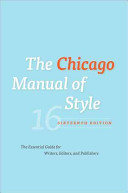Is Chicago style better online?
Author: Ellen Cline; Published: Mar 11, 2013; Category: Business Writing, Communications Tools, Editing and Proofing; Tags: editing, online reference tool, style guides, style manuals; No Comments

If you’ve read my previous blog post about style guides, you know I prefer The Chicago Manual of Style to the Associated Press Stylebook.
I finally signed up for an online subscription to Chicago and am really finding it useful. Rather than buy a new hardcover version of Chicago to get the 16th edition, I chose to purchase an online subscription instead.
Although I still do love using paper books, I spend most of my time working at the computer, as I have for years. So searching the online version for reference, is quick and convenient. And there are some added features.
Using the online version, you can search the 15th or 16th edition. Select which you want before entering words into the search bar. As an alternative, you can use the table of contents, drilling down through each chapter to see more detail. If you’ve always liked searching the paper manual through its index, you can still do that online as well.
In addition to the book, you can also search the Q&A section of the website. Although Chicago is pretty thorough, there are situations that come up that may not be covered in the manual, and peoples’ questions and the experts’ answers can be applicable to a similar situation you’re facing.
Another nice feature: You can create a style sheet for a particular client or project. Yes, it’s just a little text editor that pops up, but at least all the exceptions to Chicago you’re using will be in one place, right there with the manual.
I also like the bookmark feature. Of course you can bookmark a paper book, as I do, but after there are a million little sticky notes and scraps of paper hanging out, it gets a bit unwieldy. To bookmark the online Chicago, you just click the flag icon.
The online subscription version also lets you create your own annotations on any item. Say you want to note on 6.45, commas with dates, that you want to follow the ISO style for dates (9.37). You can do that with the little pop up text editor by clicking on the pencil icon.
I haven’t been using the online Chicago for very long yet, but so far I’m happy with it. Is anyone else using this handy tool? If so, what do you think about it?
Tools that Work–Visual Thesaurus
Author: Ellen Cline; Published: May 11, 2010; Category: Business Writing, Communications Tools; Tags: Business Writing, online reference tool, thesaurus, writing tools; No Comments
I learned about the Visual Thesaurus years before I became a subscriber. I thought of it as this interesting toy that I would try occasionally using the “trial” feature on the site, which still exists today.
Have you tried it? Just go to the Visual Thesaurus and type in a word. This little Tinkertoy-like structure will appear on the screen, showing you the word you selected and arrayed around it, all the related words. The “word map” (their term) doesn’t just pop up; that doesn’t really do it justice. It’s more like this quivering creature, gyrating into a standing position after doing it’s “look at me” dance.
But beyond the cool visual appeal, the Visual Thesaurus is useful. Click on any of the words in the little word constellation, and it becomes the center, with its related terms circling it. See the definition(s), save words you’re interested in, and more. Just be careful or you could end up traveling through this universe of words for hours.
I finally got tired of using the trial feature, broke down and paid up on an annual subscription a couple years ago. After decades of using the tried and true Roget’s Thesaurus in print form, I decided the online Visual Thesaurus was worth having.
Numb fingers from all the flipping from the index to the numbered items in the Roget’s? I did used to really give the book a workout when coming up with company or product names, headlines or taglines. So perhaps that’s part of it, but it’s also that the Visual Thesaurus offers a lot more than just the thesaurus.
You can sign up to have the Word of the Day sent to you. There are all sorts of interesting articles and blog posts in their online magazine. With their little tool you can add to your Microsoft Word program, all you have to do is right click on a word and boom, the thesaurus comes up.
I like getting the Word of the Day email each morning. It’s always an interesting tidbit about the origin of a word. Entertaining and educational, what more could you want? I feel like I’m getting smarter, learning, or being reminded of the roots of words, their meanings and why they’re spelled the way they are. It’s a nice warm up before writing.
No, I’m not being paid to plug, push, advertise, or promote the Visual Thesaurus. It’s just something I really like and want to share.

